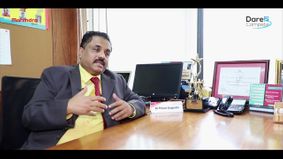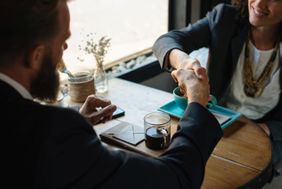- Step 1: The Groundwork
- Step 2: The Three Sections
- Step 3: Practice Makes Improvement
- The Secret Ingredient
- Understanding Basics Of Number Series
- Types Of Number Series Reasoning Questions
- Addition & Multiplication In Number Series
- Square & Cube-Based Number Series Patterns
- Missing Terms & Arranging Sequences
- Tricks & Tips For Solving Number Series
- Selected Number Series Questions With Solutions
- Frequently Asked Questions (FAQs)
- Must Know Terminologies in Blood Relation Questions
- Basic Approaches to Solve Blood Relation Questions
- Types Of Blood Relation Questions
- Tips For Solving Blood Relation Questions
- Multiple Choice Questions (MCQs) with Detailed Explanation
- Conclusion
- Frequently Asked Questions (FAQs)
- Letter Series In Logical Reasoning
- Types Of Letter Series Patterns
- Tips For Solving Letter Series Reasoning
- Best Practice Question Samples With Answers
- Conclusion
- Frequently Asked Questions (FAQs)
- Basics of Problems On Age-Related Questions
- Formula to Solve Problems on Ages-Related Questions
- Types of Age-Related Questions & Examples
- Tips & Tricks for Solving Ages Problems
- Best MCQs on Problems on ages with solved answers
- Conclusion
- Frequently Asked Questions (FAQs)
- Definition of Calendar
- Understanding Days of the Week
- What is a Leap Year?
- Concept of Odd Days in a Century
- Tips For Solving Calendar Reasoning Questions
- Best Calendar Reasoning Questions with Answers (MCQs)
- Frequently Asked Questions (FAQs)
- Basic Concepts of Clock
- Structure of a Clock
- Angle Equilavalence in Clock
- Tips For Solving Clock Questions
- Selected Clock Questions & Answers (MCQs)
- Conclusion
- Frequently Asked Questions (FAQs)
- Understanding The Concept Of Direction Sense
- Tips For Effective Problem-Solving In Direction Sense
- Practical Test Practice Questions And Answers
- Conclusion
- Frequently Asked Questions (FAQs)
- Importance Of Dice Reasoning
- Dice Numbers In Dice Reasoning
- Classification Of Dice
- Constructed Vs Deconstructed Dice
- Tricks & Tips For Solving Dice Problems
- Practice MCQs With Detailed Answers
- Conclusion
- Frequently Asked Questions (FAQs)
- Alphanumeric Series Defined
- Alphanumeric Series In Reasoning Tests
- Tips & Strategies For Solving Alphanumeric Series
- Practice Sample Questions With Detailed Answers
- Conclusion
- Frequently Asked Questions (FAQs)
- Concept Of Mirror Image Reasoning Explained
- Important Terms In Mirror Image Reasoning
- Types Of Mirror Images
- Identifying Correct Mirror Image
- Finding Clock's Mirror Image
- Tips To Solve Mirror Images
- Selected Practice Questions With Answers
- Conclusion
- Frequently Asked Questions (FAQs)
- Concept & Overview Of Input-Output
- Input-Output In Competitive Exams
- Types Of Input-Output Problems
- Strategies, Tips & Tricks For Solving Reasoning Questions
- Selected Practice Questions With Answers
- Conclusion
- Frequently Asked Questions (FAQs)
- Importance Of Finding The Odd One Out
- Tricks And Tips
- How to Find The Odd One Out?
- Solved MCQs with Detailed Explanation
- Conclusion
- Frequently Asked Questions (FAQs)
- Understanding Key Concepts
- Exploring Different Ranking Types
- Formula And Application Of Order And Ranking
- Tips For Solving Order & Ranking
- Selected Practice Questions And Answers
- Conclusion
- Frequently Asked Questions (FAQs)
- Importance Of Pipes & Cistern Aptitude
- Key Terminologies used in Pipes and Cisterns
- Pipes and Cisterns Formula with Examples
- Pipes and Cisterns Shortcut Tricks
- Tips For Solving Pipes & Cistern Problems
- Selected Questions & Answers For Practice (MCQs)
- Conclusion
- Frequently Asked Questions (FAQs)
- Key Concept in Boats and Streams
- Formulas Of Boats & Streams
- Distance & Time Formula
- Tips For Solving Boats & Streams Questions
- Selected Practice Questions With Answers (MCQs)
- Conclusion
- Frequently Asked Questions (FAQs)
- Concept of Mixture and Alligation
- Types Of Alligation Questions
- Formula for Solving Mixture & Alligation
- Tips For Solving Mixture And Alligation
- Selected Questions With Answers For Practice
- Conclusion
- Frequently Asked Questions (FAQs)
- Concepts and Definitions Related to Time and Work
- Important Time And Work Formulas
- Tricks and Tips to Solve Time & Work Questions
- Time And Work MCQs with Detailed Solution
- Conclusion
- Frequently Asked Questions (FAQs)
- What is Harmonic Progression(HP)?
- Formula to find the nth Term in Harmonic Progression
- Formula to find the Sum of the nth Term in HP
- What is Harmonic Mean?
- Harmonic Progression Solved Best MCQs
- Conclusion
- Frequently Asked Questions (FAQs)
- What is Mensuration in Maths?
- What are 2D figures in Mensuration?
- What are 3D figures in Mensuartion?
- Basic Terminologies In Mensuration
- Basic 2D Formulas in Mensuration
- Basic 3D Formulas in Mensuration
- 2D vs 3D in Mensuration
- Solved Questions With Solutions (MCQs)
- Conclusion
- Frequently Asked Questions (FAQs)
- Relationship Between Time, Speed And Distance
- Conversion Units Time, Speed And Distance
- Average & Relative Speed: Two Trains Moving in the same or opposite direction
- Solved MCQs on Time, Speed And Distance
- Conclusion
- Frequently Asked Questions (FAQs)
- What is Simplification in Maths?
- BODMAS Rule in Simplification Explained
- Simplification & Approximation Relation
- Key Terms in Simplification
- Examples Of Simplification Techniques
- Simplification Questions With Solved Answers (MCQs)
- Conclusion
- Frequently Asked Questions (FAQs)
- Height And Distance Important Terms
- Right Angled Triangle In Trigonometry
- Trigonometric Ratios
- Solved Examples For Better Understanding
- Height And Distance Applications In Trigonometry
- Height And Distance Practice Questions & Answers
- Conclusion
- Frequently Asked Questions (FAQs)
- Defining Interest Types
- Simple Interest Vs. Compound Interest
- Selected Solved Questions & Answers
- Conclusion
- Frequently Asked Questions (FAQs)
- Basic Concepts Of Profit And Loss
- Determining Selling Price
- Calculating Discounts
- Formulas For Calculating Profit And Loss
- Examples Of Profit And Loss
- Profit & Loss Questions With Detailed Solution
- Conclusion
- Frequently Asked Questions (FAQs)
- Defining Angle Of Elevation
- Key Terms Used In Angle Of Elevation
- Angle of Elevation Formula with Example
- Angle of Elevation vs. Angle of Depression
- Angle of Elevation MCQs with Answers
- Conclusion
- Frequently Asked Questions (FAQs)
- Defining HCF And LCM
- Calculation Methods Of HCF And LCM
- HCF By Prime Factorization Method
- LCM By Prime Factorization Method
- Difference Between HCF And LCM
- HCF & LCM Practice Questions With Answers
- Conclusion
- Frequently Asked Questions (FAQs)
- What is fraction and decimal?
- Understanding Decimal Fraction
- Place Value in Decimal Fraction
- Mathematical Operations with Decimal Fraction
- Practice with Solved Examples
- Summary
- Frequently Asked Questions
- All About Decimals
- All About Fractions
- How to Convert a Decimal into Fraction
- Simple vs Recurring Decimals
- Converting Recurring Decimals to Fractions
- Conversion Charts
- Practice Questions (With Solutions)
- Closing Thoughts
- Frequently Asked Questions
- What is Arithmetic Mean?
- Arithmetic Mean Formula- Ungroup Data & Group Data
- Merits of Arithmetic Mean
- Demerits of Arithmetic Mean
- Alternatives to Arithmetic Mean
- What is the Weighted Arithmetic Mean?
- Arithmetic vs. Geometric Mean
- Arithmetic Mean Application in Statistical Analysis
- Arithmetic Mean Practice Questions with Explanation
- Frequently Asked Questions
- What is Geometric Progression?
- Key Properties of Geometric Progression
- General Form Of Geometric Progression
- General Term or the Nth Term of Geometric Progression
- The sum of nth Terms of GP
- Types Of Geometric Progression
- Solved Questions and Answers of GP
- Conclusion
- Frequently Asked Questions (FAQs)
- Average in Maths
- Average Formula in Maths
- Differentiating Types of Average
- How to Calculate Average of Negative Numbers?
- Practical Applications of Averages
- Average Questions For Practice
- Frequently Asked Questions
- What is Simple Interest in Maths?
- Simple Interest Formula Explained
- Simple Interest Formula for Years, Months & Days
- Simple Interest Examples & Practice Questions
- Conclusion
- Frequently Asked Questions (FAQs)
- Defining Mathematical Ratios
- Understanding Proportions Fundamentals
- Differentiating Ratios from Proportions
- Ratio and Proportion Formulas
- Properties of Ratio and Proportion
- How to Solve Ratio and Proportion Problems
- Ratio and Proportion Problems (With Solutions)
- Summary
- Frequently Asked Questions
- What is Number in Maths?
- Types of Numbers With Example
- Real vs Complex Numbers Explored
- Basic Operations on Numbers
- Practice Questions (With Solutions)
- Frequently Asked Questions
- What is Arithmetic Progression (AP) in Maths?
- Important Terminologies in Arithmetic Progression
- Basic Terms in Arithmetic Progression
- General Form Of Arithmetic Progression Series
- Types Of Arithmetic Progression
- Solved Questions With Explanation (MCQs)
- Conclusion
- Frequently Asked Questions (FAQs)
- Understanding Basic Concept
- Importance Of Train Problems In Aptitude
- Tips To Solve Train Problems
- Selected Practice Questions & Answers
- Conclusion
- Frequently Asked Questions (FAQs)
- Definition Of Mode
- Calculating Mode For Ungrouped Data
- Calculating Mode For Grouped Data
- Bimodal, Trimodal & Multimodal Distributions
- Comparing Mean, Median & Mode
- Selected Practice Questions With Answers
- Conclusion
- Frequently Asked Questions (FAQs)
- Important Concept In Races And Games
- Calculating Time, Speed & Distance
- Importance Of Races And Games Problems
- Sample Practice Questions With Answers
- Conclusion
- Frequently Asked Questions (FAQs)
- Types Of Partnership
- Formula For Partnership Questions
- Tips To Solve Partnership Aptitude Questions
- Selected Partnership Questions (Practice MCQs)
- Conclusion
- Frequently Asked Questions (FAQs)
Dice Reasoning: Types & Tricks Explained With Question & Answer

Understanding how to use dice reasoning effectively can improve students' critical thinking abilities by up to 50%. This can be particularly useful when faced with challenging exam questions or decision-making during job interviews.
By incorporating dice reasoning into their study and preparation routines, students can enhance their cognitive abilities and increase their chances of success in exams and job placements.
Importance Of Dice Reasoning
Let us study the importance of dice reasoning in detail:
Competitive Exams
In competitive exams, dice-based questions assess candidates' ability to apply logic and reasoning under time constraints. These questions often require candidates to decipher patterns, sequences, and relationships between numbers displayed on the faces of the dice.
Enhances Problem-Solving
Dice reasoning plays a crucial role in logical reasoning tests by challenging individuals to think critically and analytically. By incorporating dice into reasoning assessments, individuals are required to visualize and manipulate various outcomes, thus significantly enhancing their problem-solving skills.

Dice Numbers In Dice Reasoning
Let us understand how dice numbers work in dice reasoning:

Arrangement
Dice are numbered in a way that the sum of numbers on opposite faces always equals the total number of faces plus one. For instance, a standard six-sided dice has opposite faces, adding up to seven.
Relationship
Opposite faces on dice are designed always to equal the total number of sides plus one when you add the numbers together. This principle applies to all types of dice, ensuring fairness and randomness in games and probability calculations.
Numbering Scheme Rules
The numbering scheme on dice follows specific rules to maintain consistency and fairness. Each face is marked with a different number, ensuring that no two faces with adjacent numbers are placed next to each other.
This arrangement prevents bias and ensures random outcomes in various applications such as board games and gambling.
Classification Of Dice
Let us study the classification of dice in dice reasoning:
Base Dice
Base dice are primarily cuboid in shape, featuring numbers on each face from 1 to 6. They are commonly used in traditional board games. These dice offer a straightforward approach to gaming, with clear outcomes determined by the number rolled.
Open Dice
In contrast, open dice have an irregular shape, which sets them apart from the standard cuboid form. This uniqueness introduces a level of complexity and unpredictability to games that utilize them. Open dice often come with varying numbers of faces, ranging from four to twenty or more.
Standard Dice
Standard dice adhere to the classic six-sided cuboid design, ensuring uniformity and consistency in gameplay. Standard dice maintain a predictable outcome due to their symmetrical structure.
Ordinary Dice
Ordinary dice encompass a broader category, including base and open dice variations. Also, ordinary dice introduce an element of surprise and strategy.
Constructed Vs Deconstructed Dice
Let us study the constructed and deconstructed dice in dice reasoning:
Defined Problems
Constructed dice involve assembling a three-dimensional cube with numbers placed on each face. On the other hand, deconstructed dice problems require you to visualize a two-dimensional flat shape representing a die. Imagine a cube where 1 is opposite 6, 2 is opposite 5, and 3 is opposite 4.
To understand constructed dice, imagine folding the flat shape into a cube to see how the numbers align on different faces. For deconstructed dice, picture laying out the cube and identifying which numbers are opposite. Visualize a flattened-out cube showing all six faces with numbers arranged in a specific pattern.
Tricks & Tips For Solving Dice Problems
Let us study some of the tricks and tips for solving dice problems in reasoning:
Approach Strategies
When tackling dice reasoning problems, start by visualizing the dice's different positions. Understand that each face has a specific rule: the sum of numbers on opposite sides is always seven. Familiarize yourself with the rules governing dice and the possible outcomes in various scenarios.
Regular Practice
Regular practice is crucial for mastering dice reasoning. By practising consistently, students can improve their aptitude for deciphering complex dice problems efficiently. Moreover, practice helps in developing a keen eye for detail when analyzing dice configurations.
Grasp The Logic
Dice reasoning plays a crucial role in logical reasoning questions, especially in interviews and mock tests. By grasping the logic behind dice configurations, candidates can effectively tackle verbal reasoning problems. This involves analyzing the patterns of symbols and numbers on the different faces of a dice.
Mental Manipulation
One effective technique for tackling verbal reasoning questions related to dice is to visualize the dice's rotations in your mind. This mental manipulation helps you determine how the symbols or numbers would appear on each face after rotation..
Practice MCQs With Detailed Answers
Solving a variety of practice questions is key to mastering dice-based multiple-choice questions (MCQs). Provided below are some of the best-selected dice-based reasoning questions and answers:

Question 1: If two dice are thrown simultaneously, what is the probability of getting two numbers whose product is even?
a) 1/2
b) 1/4
c) 3/4
d) 1/3
Answer: c) 3/4
Explanation: In a throw of two dice, there are 36 possible outcomes. Out of these, 27 outcomes have the product of two numbers as even. So, the required probability = 27/36 = 3/4
Question 2: A die is thrown twice; what is the probability that the sum of the numbers appearing on the dice is 11?
a) 1/9
b) 1/12
c) 1/6
d) 1/18
Answer: d) 1/18
Explanation: There are 36 possible outcomes when a die is thrown twice. The event of getting the sum of the numbers as 11 is 5,6 and 6,5. So, there are 2 favourable outcomes. Therefore, the required probability = 2/36 = 1/18.
Question 3: If two dice are thrown simultaneously, what is the probability of getting two numbers whose product is odd?
a) 1/2
b) 1/4
c) 3/4
d) 1/3
Answer: b) 1/4
Explanation: In a throw of two dice, there are 36 possible outcomes. Out of these, 9 outcomes have the product of two numbers as odd. So, the required probability = 9/36 = 1/4.
Question 4: A die is thrown twice; what is the probability that the sum of the numbers appearing on the dice is 7?
a) 1/9
b) 1/6
c) 1/12
d) 1/8
Answer: b) 1/6
Explanation: There are 36 possible outcomes when a die is thrown twice. The event of getting the sum of the numbers as 7 is (1,6), (2,5), (3,4), (4,3), (5,2), (6,1). So, there are 6 favourable outcomes. Therefore, the required probability = 6/36 = 1/6.
Question 5: If two dice are thrown simultaneously, what is the probability of getting two numbers whose product is prime?
a) 1/2
b) 1/4
c) 1/6
d) 1/3
Answer: c) 1/6
Explanation: In a throw of two dice, there are 36 possible outcomes. Out of these, 15 outcomes have the product of two numbers as prime. So, the required probability = 15/36 = 5/12.
Question 6: A die is thrown twice; what is the probability that the sum of the numbers appearing on the dice is 10?
a) 1/9
b) 1/12
c) 1/6
d) 1/8
Answer: b) 1/12
Explanation: There are 36 possible outcomes when a die is thrown twice. The event of getting the sum of the numbers as 10 is (4,6), (5,5), (6,4). So, there are 3 favourable outcomes. Therefore, the required probability = 3/36 = 1/12.
Question 7: If two dice are thrown simultaneously, what is the probability of getting two numbers whose product is divisible by 3?
a) 1/2
b) 1/4
c) 3/4
d) 1/3
Answer: a) 1/2
Explanation: In a throw of two dice, there are 36 possible outcomes. Out of these, 18 outcomes have the product of two numbers divisible by 3. So, the required probability = 18/36 = 1/2.
Question 8: A die is thrown twice; what is the probability that the sum of the numbers appearing on the dice is 9?
a) 1/9
b) 1/12
c) 1/6
d) 1/8
Answer: a) 1/9
Explanation: There are 36 possible outcomes when a die is thrown twice. The event of getting the sum of the numbers as 9 is (3,6), (4,5), (5,4), (6,3). So, there are 4 favourable outcomes. Therefore, the required probability = 4/36 = 1/9.
Question 9: A die is thrown twice; what is the probability that the difference between the numbers appearing on the dice is 1?
a) 1/9
b) 5/18
c) 1/6
d) 1/8
Answer: b) 5/18
Explanation: There are 36 possible outcomes when a die is thrown twice. The event of getting the difference of the numbers as 1 is (1,2), (2,1), (2,3), (3,2), (3,4), (4,3), (4,5), (5,4), (5,6), (6,5). So, there are 10 favourable outcomes. Therefore, the required probability = 10/36 = 5/18.
Question 10: A die is thrown twice; what is the probability that the difference of the numbers appearing on the dice is 2?
a) 1/9
b) 2/9
c) 1/12
d) 1/8
Answer: b) 2/9
Explanation: There are 36 possible outcomes when a die is thrown twice. The event of getting the difference of the numbers as 2 is (1,3), (3,1), (2,4), (4,2), (3,5), (5,3), (4,6), (6,4). So, there are 8 favourable outcomes. Therefore, the required probability = 8/36 = 2/9.
Conclusion
Mastering dice reasoning unlocks a valuable tool for enhancing your problem-solving skills and acing various MCQs. Practice solving problems and challenging yourself with diverse scenarios to solidify your understanding.
Remember, the more you engage with dice reasoning, the sharper your analytical skills become. Keep honing your abilities, and watch as your proficiency in reasoning reaches new heights.
Quiz Time To Test Your Mind
Frequently Asked Questions (FAQs)
1. What is the significance of understanding dice in reasoning?
Understanding dice in reasoning is crucial as it enhances problem-solving skills, aids in tackling verbal reasoning questions effectively, and improves overall cognitive abilities by mastering dice-based MCQs.
2. How are dice numbers classified?
Dice numbers are categorized based on their positions and relationships on the dice's faces. This classification helps differentiate between regular and irregular dice patterns for various reasoning exercises.
3. What distinguishes constructed from deconstructed dice?
Constructed dice refer to standard, solid structures with predefined number arrangements on opposite faces, while deconstructed dice involve rearranging these numbers to form new configurations. This distinction impacts the complexity of reasoning tasks involving dice manipulation.
4. How does understanding dice enhance problem-solving skills?
Understanding dice enables individuals to visualize spatial relationships, analyze patterns efficiently, and develop logical thinking strategies essential for solving complex problems across various domains beyond just mathematical reasoning.
5. Why are verbal reasoning questions important when dealing with dice problems?
Verbal reasoning questions provide context and additional challenges when working with dice problems, requiring individuals to interpret instructions accurately, apply critical thinking skills, and make informed decisions based on the given information.
Suggested reads:
- Data Interpretation: Definition, Steps, & Practice Questions
- What Is Number In Maths: History, Types, Operations & More
- Ratio and Proportion: Mastering Fundamentals (+ Solved Questions)
- Arithmetic Progression- Notation, Formulas, Questions And Answers
- Geometric Progression- Definition, Formula, Questions & Answers
Instinctively, I fall for nature, music, humor, reading, writing, listening, traveling, observing, learning, unlearning, friendship, exercise, etc., all these from the cradle to the grave- that's ME! It's my irrefutable belief in the uniqueness of all. I'll vehemently defend your right to be your best while I expect the same from you!
Login to continue reading
And access exclusive content, personalized recommendations, and career-boosting opportunities.
Subscribe
to our newsletter
















Comments
Add comment